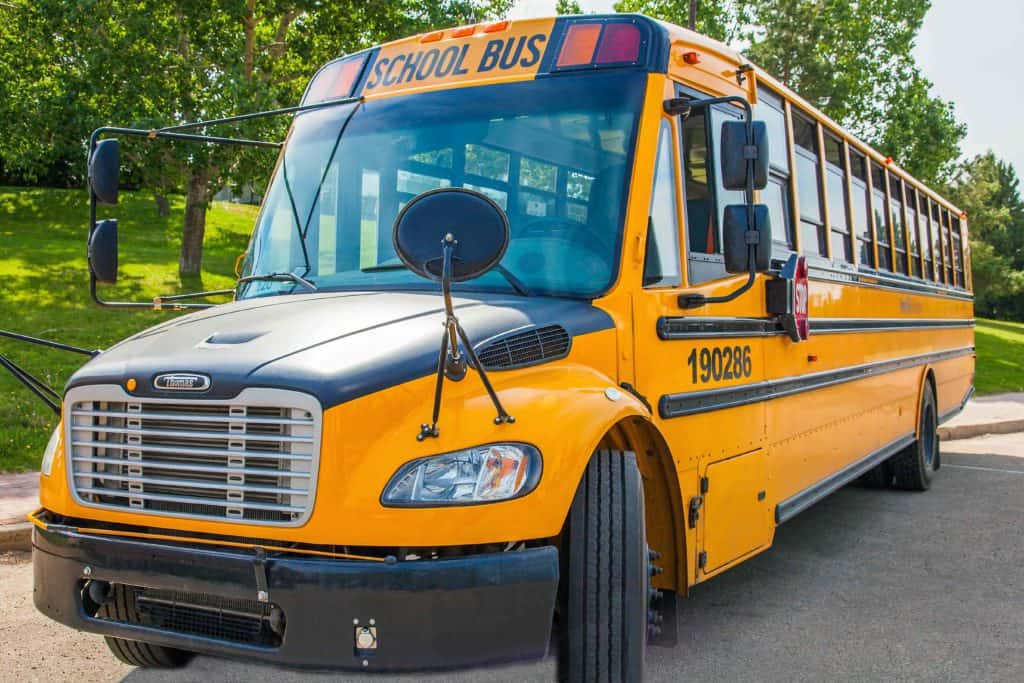In the United States, about 26 million students ride school buses daily. In addition, there are about 480,000 school buses that transport United States students to school. Since millions of students use the school bus as a form of transportation, it’s your job to keep them safe.
This means your school bus fleet has very little room for error and must always be operating efficiently. Unauthorized route changes, breakdowns, late drop-offs, or pick-ups may leave students stranded and cause teachers and parents to express their frustration against the school bus drivers. You don’t want to have to answer questions from disgruntled parents or faculty.
However, there are things that school bus fleet managers can do to prevent these issues, such as hiring reliable drivers and installing the right fleet management software. In addition, you’ll need to supervise your bus fleet effectively.
Investing in the right school bus fleet management software will also save you money and increase the safety of students. We’ve compiled the best tips for managing your school bus fleet operations.
Actively Maintain Your School Bus Fleets
When it comes to student ridership, downtime isn’t an option. Every bus needs to transport dozens of students to class for the morning pick-up and drop-off. If drivers are running late, you’ll hear complaints from parents, school officials, and school districts. If there is an unexpected breakdown, you’ll need to scramble around to get a replacement bus.
Having a preventative maintenance schedule will save you money in maintenance costs because it prevents the likelihood of emergency breakdowns. In addition, by being proactive in your approach, you stop potential issues from occurring before they turn into safety hazards.
Adhering to the best practices of proper maintenance process for your vehicles helps to verify the safety of your vehicles, ensure your fleet is operating smoothly and maximize uptime. In addition, bus routing software allows you to easily build a routine schedule that your bus drivers can stick to.
In addition, fleet management software will enable you to track important metrics like engine diagnostics and even set up a service schedule that has alert notifications to remind you when an upcoming service is needed. This allows your entire bus fleet to stay on top of maintenance schedules.

Use GPS Tracking and Fleet Management Software
Real-time tracking is vital to ensure your school buses are arriving and departing on time. If there is a breakdown, route deviation, or delay, a GPS fleet tracking software can alert you, so you can quickly send another bus as a replacement. In addition, with telematics devices, a bus fleet management team can monitor and share every vehicle location with the school districts and administrators.
Transparency and communication are also crucial. When an issue arises, you’ll be informed in real time, and you can alert the school administration.
In addition, GPS systems can record student ridership in a school bus through Radio Frequency Identification (RFID) cards to track when students enter and exit a school bus.
Measure Fuel Usage for Your School Buses
Fleet efficiency can be determined by fuel usage. Operating a school bus fleet can be quite expensive; therefore, managing fuel expenses is crucial. One EPA study found that a school bus burns about half a gallon of fuel every hour. This means that if a school bus remains idle for 30 minutes daily, that adds up to 45 gallons of fuel annually. Larger size buses will even burn more fuel. Imagine what the fuel consumption would be for an entire school bus fleet. Some experts claim that some school bus fleets have 40 to 50% of their total run time allocated to idling.
Having bus fleet management software is one of the effective ways to track idle time on your vehicles and other factors that contribute to increased fuel costs. This may include poor driver behavior like aggressive driving, speeding, sudden braking, sharp turns, or even poor planning by bus fleet managers.
A bus fleet management software also simplifies the entire data collection process and stores inspection forms—no more worrying about losing paper receipts.
Maximize the Lifespan of Your School Buses
Replacing a school bus is quite costly. Tracking and retrieving asset data will allow school bus fleet managers to monitor how their vehicles are being used. As a result, you and your drivers will maximize the most out of your vehicles.
After implementing GPS tracking software, your fleet managers will be able to collect pertinent information like miles traveled per day for each school bus. Your fleet management will be much more effective since you’ll be able to stay on top of maintenance schedules, increasing the vehicle lifespan. In addition, you’ll also track fuel usage and optimize fleet performance. With all of the inspections you’ll run by performing routine maintenance; you’ll collect data to provide a top-down view of your entire school bus fleet. Recognizing these patterns within your fleet will allow you to implement the key maintenance measures to protect the vehicle from breaking down.
Switch Your Reports from Paperless System to Software

In the past, drivers would have to fill out various permission slips, route maps, and inspection forms on paper, which was a big hassle. With vehicle tracking software, managing school bus fleets are much easier. Information is stored on cloud technology and can be accessed from anywhere around the world.
This also means you have real-time information and updates, allowing you to make changes on the go.
Improve Safety
A school bus fleet management software is one of the most effective options to improve driving behavior. They provide detailed insight into the driver’s behavior. For example, some software solutions offer scorecard reports that compile information and develop a driving score. The driver score can be a metric used for their performance and success. Factors that affect the score are speeding, drive time, the route is taken, idle time, and others.
Fleet managers can use this data to enforce safety-related best practices and address unsafe driving behaviors. For example, some school bus fleet management companies have a safe driving program where the goal is to incentivize drivers to practice safe driving at all times. This can be through monetary benefits, recognition, and other incentives.
Fleet management solutions can also improve student safety by helping fleet managers to:
- Identify the safe pick-up and drop-off spots for students using GPS technology.
- Use the information collected to determine an effective onboarding, training, and coaching school bus drivers.
- Respond to heavy traffic and weather conditions to ensure all students are safe.
- Implement real-time tracking for their school bus fleet.
- Ensure that all drivers in their school bus fleet stick to only approved bus routes, avoid harsh braking and acceleration, and always follow speed limits.
- Driveri smart cameras can also record live road conditions as well as the safety for the driver and students.
Lower School Transportation Costs
When you are operating a school bus fleet management company, it can be a challenge to manage the cost of your business, such as your assets, maintenance, and hiring. It’s more important than ever to ensure that fleet managers and owners maximize every dollar in their budget. Many tracking solutions can help to reduce operational expenses and increase efficiency through these methods:
- Incorporate a safety program for school bus fleets, which allows your company to get access to lower insurance premiums.
- Ensure all bus drivers are properly training and ensure proper route planning to reduce damages and maintenance for every vehicle in your fleet. As a result, the bus lifespan will increase.
- Eliminate and reduce inefficient bus routes, speeding, and idling time to reduce overall fuel usage.
- Perform preventative maintenance and equipment monitoring to lower costs. As a result, the fleets will remain in tip-top condition, which avoids breakdowns, downtime, and unplanned repairs.
- Use Driveri cameras for in depth driver coaching sessions to improve overall fleet safety.
Fleet management technology can truly deliver cost-cutting benefits by increasing vehicle utilization, lowering vehicle idle time, and reducing fuel costs.
Adopt Accountability
Efficiency and safety aren’t the only concerns that a school bus fleet company needs to worry about. There are other initiatives that fleet telematics can help with:
Ensure data-driven decision making
Fleet managers can use various data points to adjust routes as needed and respond to emergencies when called upon. Telematics technology streamlines the overall transportation management, improves vehicle utilization, enhances safety, and ensures smarter decision making.
For example, let’s say you notice drivers display poor driving behavior such as not following routes, speeding, or exhibit other aggressive driving behaviors. You can implement driving safety programs to address the issue. Or if you notice vehicle maintenance issues, you can fix those too.

Maintain State and Federal Transportation Compliance
The Department of Transportation (DOT) and the Federal Motor Carrier Safety Administration (FMCSA) is known to have many regulations for fleet management.
Rather than struggling to comply with regulations, fleet telematics helps to automate data collection and record-keeping. In addition, it’ll notify you when safety standards aren’t met. If you fail to comply with the regulations your organization could be penalized.
Meet Environmental Goals
Although the environmental impact may not be at the forefront of your mind, it can be a great way to exhibit confidence in schools and parents. Telematics can improve your fleet’s carbon footprint by tracking bus usage and optimizing routes. Many of the important data will be tracked, such as fuel usage, speeding, and idling.
You can take it one step further by reducing the total concentrated diesel exhaust emissions and improve air quality emitting from your bus fleet. Bad emissions from your vehicles can especially be detrimental for young children who suffer from asthma and allergies. It can cause throat and acute eye irritation and even interfere with a child’s lung development.
As a fleet company, you can proudly report on the fleet metrics about your green initiatives to the DOE or OPT (Office of Pupil Transportation), parents, and school administration, that you stand out from other vendors in the market.
Final Thoughts
Make sure that the school bus telematics solution you decide to go with handles all of your current fleet needs. It should also be flexible enough to adapt to potential challenges that arise.
Some of the key features you may want to consider are:
- Intuitive dashboards that offer real-time reporting and fleet analytics
- Detailed GPS maps that display the activities and locations of vehicles, drivers, and equipment.
- Provide coaching modules to assist fleet managers in helping their drivers with safe driving practices.
- The telematics software should be able to access through the cloud so that you can manage your fleet from anywhere.

1 thought on “Tips for School Bus Fleet Management in 2024”
Im very happy to find this web site. I want to to thank you for ones time just for this fantastic read!! I definitely appreciated every part of it and i also have you saved as a favorite to see new information in your blog.